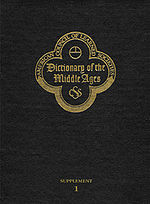
Dictionary of the Middle Ages
Encyclopedia

Encyclopedia
An encyclopedia is a type of reference work, a compendium holding a summary of information from either all branches of knowledge or a particular branch of knowledge....
of the Middle Ages
Middle Ages
The Middle Ages is a periodization of European history from the 5th century to the 15th century. The Middle Ages follows the fall of the Western Roman Empire in 476 and precedes the Early Modern Era. It is the middle period of a three-period division of Western history: Classic, Medieval and Modern...
published by the American Council of Learned Societies
American Council of Learned Societies
The American Council of Learned Societies , founded in 1919, is a private nonprofit federation of seventy scholarly organizations.ACLS is best known as a funder of humanities research through fellowships and grants awards. ACLS Fellowships are designed to permit scholars holding the Ph.D...
between 1982 and 1989. It was first conceived and started in 1975 with American medieval historian Joseph Strayer
Joseph Strayer
Joseph Reese Strayer was an American medievalist historian. He was a student of, and mentored by, Charles H. Haskins, America's first prominent medievalist historian.-Life:...
of Princeton University
Princeton University
Princeton University is a private research university located in Princeton, New Jersey, United States. The school is one of the eight universities of the Ivy League, and is one of the nine Colonial Colleges founded before the American Revolution....
as editor-in-chief. A "Supplement 1" was added in 2003 under the editorship of William Chester Jordan
William Chester Jordan
William Chester Jordan is an American medievalist, in which field he is a Haskins Medal winner. He is currently the Dayton-Stockton Professor of History and Chairman of the History Department at Princeton University. He is also a former Director of the Program in Medieval Studies at Princeton...
.
The encyclopedia covers over 112,000 persons, places, things and concepts of "legitimate scholarly interest" in 7,000 discrete articles in more than 8,000 pages written by over 1,800 contributing editors from academic institutions mainly in the United States but also Europe and Asia
It is the largest and most detailed modern encyclopedia of the Middle Ages in the English language, comparable to the nine volume German Lexikon des Mittelalters.
The "upside-down-T in a circle" symbol on the spine and cover is an artistic interpretation of the T and O map
T and O map
A T and O map or O-T or T-O map , is a type of medieval world map, sometimes also called a Beatine map or a Beatus map because one of the earliest known representations of this sort is attributed to Beatus of Liébana, an 8th-century Spanish monk...
, which was first described in the Etymologiae
Etymologiae
Etymologiae is an encyclopedia compiled by Isidore of Seville towards the end of his life. It forms a bridge between a condensed epitome of classical learning at the close of Late Antiquity and the inheritance received, in large part through Isidore's work, by the early Middle Ages...
, the most influential encyclopedic work of the Middle Ages.

